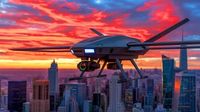On the cusp of a technological revolution, the world’s battlefields are being transformed—not by the thunder of tanks or the roar of jet engines, but by the quiet whir of autonomous drones and the cold logic of artificial intelligence. Silicon Valley, once the cradle of consumer tech and social media, is now elbowing its way into the defense sector, driven by a new breed of entrepreneurs and the relentless pressure of global conflict. At the center of this seismic shift is Steven Simoni, a former payments start-up founder who sold his company to DoorDash and now stands as a symbol of the tech industry’s march into the militarized unknown.
Simoni’s latest venture, Allen Control Systems, is the brain behind the Bullfrog—an AI-driven autonomous machine gun with a price tag of about $350,000. The Bullfrog isn’t just another gadget; it’s designed to provide cost-effective defense against the rising tide of cheap, weaponized drones that have become the scourge of modern militaries. According to reporting from the New York Times, Simoni’s journey from QR codes to advanced weaponry mirrors a broader transformation among tech visionaries, who are leaving behind the world of apps and delivery services to take on the challenges of 21st-century warfare.
“Whoever dominates AI will dominate warfare,” warns Braden Allenby, a military ethics specialist, as quoted by Der Spiegel. “The runner-up is doomed.” That stark prediction is no longer the stuff of science fiction. The conflict in Ukraine has become a testbed for these new technologies, with both sides deploying swarms of autonomous drones. Ukrainian forces, for example, have launched more than 480 modified Aeroprakt A-22 drones in a coordinated assault on Moscow, while Russian forces have retaliated with 140 Shahed drones packed with Iranian and Israeli technology. Ukraine’s defensive answer? A mobile “drone wall” powered by AI algorithms that can intercept enemy attacks in real time—a live demonstration of how algorithms are now making life-and-death decisions on the battlefield.
This isn’t just a regional phenomenon. The United States, long a leader in drone warfare, is now scrambling to keep pace with the rapid advances made by adversaries. The Pentagon has announced a $36 billion push to accelerate the development and deployment of autonomous drones, with a goal of fielding over 1,000 AI-powered units within months. Notable projects include the Manta Ray, an autonomous submarine, and the Loyal Wingman, an unmanned fighter jet designed to support human pilots. Michael Horowitz, a security expert and former Pentagon advisor, has been blunt in his criticism, telling Der Spiegel that the U.S. military’s “slow adoption of fully autonomous systems” has become a costly oversight as rivals race ahead.
Meanwhile, China is watching—and learning. Once a proponent of strict bans on autonomous weapons, Beijing has shifted gears, now focusing on regulating their use while pouring resources into development. The amphibious Feiyi drone, capable of moving seamlessly from water to air and launching attacks from submarines, is just one example of how China is preparing for potential flashpoints like Taiwan. As Der Spiegel notes, China’s pivot is motivated by the prospect of a risky amphibious assault, where autonomous systems could provide a decisive edge.
Back in the United States, Simoni’s approach to defense tech is as much about branding as it is about battlefield utility. His flamboyant persona—often seen in designer tracksuits and hosting social events for military officials—has made him a fixture in both media circles and Pentagon corridors. But this blending of personal image and lethal technology marketing raises uncomfortable questions. Can the Silicon Valley ethos of “move fast and break things” coexist with the grave ethical responsibilities of arms production? Or does it trivialize the consequences of war, turning national security into just another market ripe for disruption?
Simoni is hardly alone. Inspired by figures like Palmer Luckey of Anduril and Alex Karp of Palantir, a new wave of tech entrepreneurs is flooding the defense sector, developing everything from drone swarms to AI-directed weaponry. The urgency for these innovations is being driven by a world in flux: Russia’s invasion of Ukraine, persistent conflicts in the Middle East, and the rise of China as a military and technological superpower. As the New York Times reports, this has left traditional defense contractors scrambling to keep up, while start-ups—backed by venture capital—promise rapid, creative solutions to complex military problems.
But there’s a catch. The same “fail fast” mentality that made Silicon Valley famous could have disastrous consequences when applied to weapons systems. The Pentagon’s willingness to engage with agile start-ups like Allen Control Systems reflects a desire for speed and innovation, but it also introduces risks. Overpromises, technical failures, and a lack of accountability could have deadly consequences in real combat scenarios. “The train has already left the station,” says Allenby, highlighting the widening gap between the breakneck pace of AI innovation and the slower, more deliberate processes of political and military oversight.
And the stakes couldn’t be higher. The global race for AI dominance is fueling a new arms race, with Russia and China investing heavily in autonomous weaponry. The easy availability of these technologies raises the specter of destabilization, as smaller nations and even non-state actors gain access to tools once reserved for superpowers. As the number of autonomous drones on the Ukrainian front is expected to reach into the millions by 2025, according to Der Spiegel, the question becomes not just who will win the next battle, but who will set the rules for this new era of warfare.
The ethical dilemmas are profound. Can society accept machines deciding who lives and who dies? Who bears responsibility when an autonomous system makes a fatal mistake? Should there be international regulations—or has that opportunity already slipped away? The commercialization of warfare, fueled by private capital and start-up culture, risks turning matters of life and death into calculations of profit and loss.
Simoni’s story, then, is both a window and a warning. His company’s innovations may provide answers to urgent military threats, but his marketing bravado exposes the uneasy marriage between Silicon Valley’s disruptive spirit and the sobering realities of war. As the Pentagon embraces the dynamism of the tech sector, it must also grapple with the possibility that hype and expedience could overshadow ethics and accountability.
In the end, the future of warfare may depend not just on who builds the smartest drone or the most agile AI, but on who is willing to ask—and answer—the hardest questions about what it means to hand over the power of life and death to a machine.

